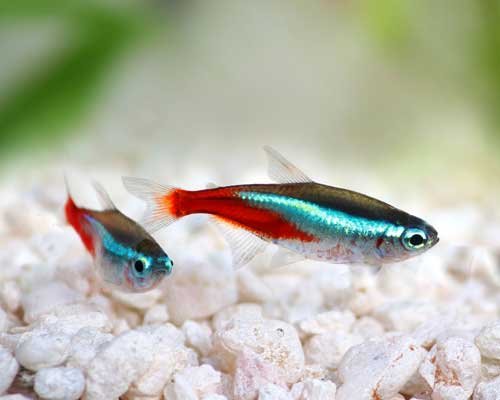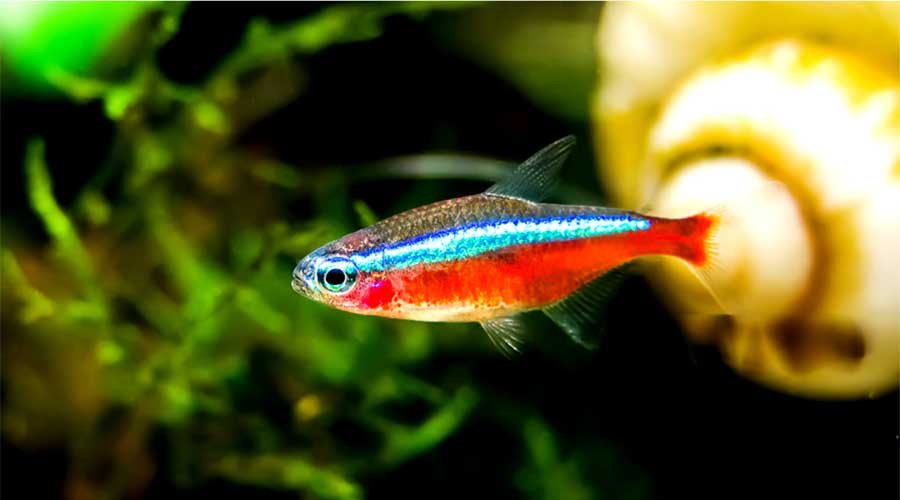Neon tetra fish care involves setting up a clean, well-maintained tank. Start with a 10-gallon tank, add a gentle filter, and maintain water temperature at 72-78°F. Use soft, acidic water and include plants for hiding spots. Feed them high-quality flakes and live foods twice daily. Regularly check water quality and perform weekly water changes to keep them healthy.
Neon tetra fish care
Neon Tetra fish are small, colorful, and easy to care for. They are popular in home aquariums. This guide will help you care for your Neon Tetra fish.
About Neon Tetra Fish

Neon Tetras are small, tropical freshwater fish native to the blackwater and clearwater streams of the Amazon Basin in South America. They are part of the Characidae family and are closely related to other popular aquarium fish like Cardinal Tetras and Green Neon Tetras. Their striking iridescent blue and red stripes make them a standout addition to any aquarium.
- Scientific Name: Paracheirodon innesi
- Common Names: Neon Tetra
- Origin: Amazon Basin (Brazil, Colombia, Peru)
- Size: 1.5 to 2 inches (3.8 to 5 cm)
- Lifespan: 5 to 8 years (with proper care)
- Temperament: Peaceful, schooling fish
Setting Up the Tank

Neon Tetra fish need a clean tank. Neon Tetras are small fish, but they are active swimmers and thrive in groups. A minimum tank size of 10 gallons is recommended for a small school of 6-8 Neon Tetras. For larger groups, a 20-gallon tank or larger is ideal. Here are the steps to set up your tank:
- Choose a tank of at least 10 gallons.
- Rinse the tank with water. Do not use soap.
- Add a layer of gravel to the bottom.
- Fill the tank with water. Use a water conditioner.
- Set up a heater. Neon Tetra fish like warm water.
- Decorate the tank with plants and hiding spots.
- Filtration: Install a filter to keep the water clean. Use a gentle filter to keep the water clean without creating strong currents, as Neon Tetras prefers calm water.
- Lighting: Neon Tetras thrive in dimly lit environments, mimicking their natural habitat. Use moderate lighting and include floating plants or tall plants to provide shade.
- Let the tank run for 24 hours before adding fish.
Water Conditions
Neon Tetra fish need good water conditions. Here are the key points:
- Temperature: 72-78°F (22-26°C)
- pH Level: 6.0-7.5
- Water Hardness: Soft to moderately hard
Check the water regularly. Use a test kit. Change 25% of the water every week. This keeps the tank clean and healthy.
Substrate and Decor
- Use a dark substrate like sand or fine gravel to mimic the riverbeds of the Amazon.
- Add plenty of live plants such as Java Moss, Amazon Sword, and Anubias to create hiding spots and replicate their natural environment.
- Include driftwood and dried leaves (like Indian Almond Leaves) to release tannins, which help soften the water and create a more natural feel.
Feeding Neon Tetra Fish
Neon Tetras are omnivores and enjoy a varied diet. In the wild, they feed on small insects, crustaceans, and plant matter. In captivity, their diet should include:
- High-Quality Flake Food or Micro Pellets: These should form the staple of their diet.
- Live or Frozen Foods: Brine shrimp, daphnia, and bloodworms are excellent protein-rich treats.
- Vegetables: Occasionally offer blanched spinach or zucchini for added nutrients.
- Feeding Schedule: Feed Neon Tetras 2-3 times a day, offering only as much food as they can consume in 2-3 minutes. Overfeeding can lead to water quality issues.
Tank Mates for Neon Tetras

Neon Tetras are peaceful and do well in community tanks with other small, non-aggressive fish. Some excellent tank mates include:
- Other Tetras: Cardinal Tetras, Ember Tetras, and Rummy Nose Tetras.
- Small Catfish: Corydoras and Otocinclus.
- Livebearers: Guppies and Endlers.
- Dwarf Cichlids: Apistogramma species.
- Shrimp and Snails: Cherry Shrimp and Nerite Snails.
Avoid keeping Neon Tetras with larger or more aggressive fish like Cichlids or Bettas, as they may see Neon Tetras as prey. Always research before adding new fish to your tank.
Health and Disease
Healthy Neon Tetra fish are active and bright. Watch for signs of disease. These include:
- Neon Tetra Disease: A fatal condition caused by a parasite. Symptoms include loss of color, lumps on the body, and difficulty swimming. There is no cure, so prevention (clean water and quarantine of new fish) is key.
- Ich (White Spot Disease): Caused by a parasite, it appears as white spots on the body. Treat with aquarium salt or medication.
- Fin Rot: Caused by poor water quality, it results in frayed or discolored fins. Improve water conditions and use antibacterial treatments if needed.
If you see these signs, check the water quality. Poor water can cause stress and disease. You may need to treat the fish with medicine. Quarantine sick fish to stop the disease from spreading.
Breeding Neon Tetra Fish
Breeding Neon Tetra fish can be fun. Here are the steps:
- Tank Setup: Use a separate 10-gallon tank with soft, acidic water (pH 5.0-6.0) and dim lighting.
- Use soft, acidic water.
- Add plants: Add fine-leaved plants like Java Moss for the eggs to attach to. Neon Tetras scatter their eggs, which hatch in 24-36 hours.
- Fry Care: Remove the adults after spawning to prevent them from eating the eggs. Feed the fry infusoria or commercial fry food until they are large enough to eat baby brine shrimp.
The female will lay eggs. The male will fertilize them. Remove the adults after spawning. The eggs will hatch in 24-36 hours. Feed the fry tiny food like infusoria or baby brine shrimp.
Tips for Keeping Neon Tetras Happy and Healthy
- Maintain Water Quality: Perform weekly water changes of 20-30% and test water parameters regularly.
- Avoid Sudden Changes: Neon Tetras are sensitive to sudden changes in water conditions. Acclimate them slowly when introducing them to a new tank.
- Provide Hiding Spots: Use plants, caves, and driftwood to create a natural environment and reduce stress.
- Keep Them in Groups: A school of 6 or more Neon Tetras will help them feel secure and display their best colors.
Behavior and Social Structure
Neon Tetras are schooling fish, meaning they feel safest and most comfortable in groups. A school of at least 6-8 Neon Tetras is recommended, but larger groups are even better. When kept in a school, they exhibit fascinating synchronized swimming behavior, creating a mesmerizing display in the aquarium.
- Peaceful Nature: Neon Tetras are non-aggressive and get along well with other small, peaceful fish.
- Activity Level: They are active swimmers and spend most of their time in the middle to lower levels of the tank.
Frequently Asked Questions
- How Often Should I Feed My Neon Tetra?
Feed your Neon Tetra twice a day. Small amounts only. - What Tank Size Is Best For Neon Tetra?
A 10-gallon tank is ideal. It gives them space to swim. - What Water Temperature Do Neon Tetras Need?
Neon Tetras prefer water between 72-78°F. This mimics their natural habitat. - Can Neon Tetras Live With Other Fish?
Yes, they are peaceful. Ideal tank mates include Guppies and Corydoras.






